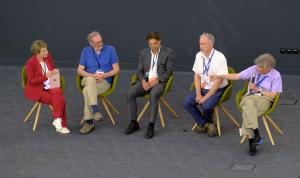Innovative approaches and how ITER can help
More than 30 private fusion companies from around the world attended ITER's inaugural Private Sector Fusion Workshop in May 2024. Four of them participated in a panel discussion on innovative fusion approaches, offering a sampling of the alternative solutions to magnetic and inertial confinement fusion that are being trialled today. Each one cited specific areas where ITER experience could help.
As representatives of fusion startups and industry gathered together with ITER staff members for the first day of the Private Sector Fusion Workshop in May, ITER Director-General Pietro Barabaschi declared that ITER was embarking on an ambitious initiative to accelerate the global fusion industry by sharing knowledge.
"ITER has largely completed the monumental task of designing and manufacturing the most powerful fusion device ever conceived and is presently in the process of assembling it. During this decades-long process, a formidable mass of experience has been accumulated, which ITER is eager to share in order to accelerate global progress," stated a follow-up report to the event.
Over two days, in panel after panel, startups took to the stage to describe their work and to articulate an answer to "How can ITER help?"
TAE Technologies, a startup from California, was the first to present itself as part of the panel on innovative fusion approaches. Founded in 1998, TAE describes its technology as "advanced accelerator beam-driven field-reversed configuration" (learn more about it here). "We have demonstrated steady state, stable operation with beta equal to 1, driven by continuous neutral beam injection," said Sergei Putvinski, senior vice president. "We also developed scenarios to start the plasma, fuel it, and control it—and we tested the diagnostic equipment that measures the main plasma parameters. The plasma lasts as long as the neutral beam is running." The company is designing its sixth-generation machine now and says it could benefit from ITER's experience in the design of plasma-facing components, remote handling for component maintenance, and superconducting coils. "And we definitely need an exchange of data—for example, databases on material properties," said Putvinski.
Michel Laberge of the Canadian firm General Fusion, agreed that the sharing of ITER-specific knowledge would be valuable to his firm. His company's innovative approach is magnetized target fusion—a technique that compresses a magnetically confined plasma using pneumatic pistons, collapsing a cavity formed in liquid metal that contains a magnetized plasma target (learn more about it here). "Our design has several advantages. First, our liquid metal wall solves the first-wall problem, eliminating the need for a complex blanket system to project the vessel. Additionally, tritium breeding and power extraction are simplified by the pure liquid lithium wall—for example, the lithium can be routed directly into a steam exchanger to produce the steam that will drive the turbines." Laberge, who had travelled to ITER once before, is interested in ITER's diagnostic development.
"Anybody that does this fusion business knows that diagnostic systems are quite difficult. You spend probably 30% of your resources developing them; for example, we built our own Thomson scattering device and our own interferometer. ITER has been working with diagnostics for a long time and we could benefit from its experience, in particular with neutron time-of-flight spectrometry."
Access to modelling and simulation codes, help validating models, and access to ITER knowledge sharing in the areas of material science, heating technologies, waste handling and magnets were cited by the Swedish company Novatron Fusion as prime examples of areas where ITER's decades of experience could facilitate its research and development. The company is currently building an open-field line confinement device with an innovative shape designed for stability (read more here).
"We have a very simple solution with clear advantages," says co-founder and chairman Erik Oden. "It's low-cost with easy fuelling and no need for a divertor to get rid of excess heat caused by neutron flux. It offers continuous steady state operation and a very high beta. All the magnets are circular, so it's easy to produce, and it's easy to mechanically stabilize." In addition to ITER's experience in fusion technology, the company says it could benefit from access to the supply chain the project has developed, and to its experience with regulatory compliance and environment/health/safety issues.
The final participant in the innovative fusion approaches panel was LPP Fusion, which has been developing a dense plasma focus device in New Jersey (USA) since 2008. According to Eric Lerner, the company's president and chief scientist, dense plasma focus devices are very compact and inexpensive, and have the advantage of using aneutronic proton-boron (p-B11) fuel. "Moreover, because the energy comes out in the form of moving electrically charged particles, there is no need for expensive equipment to convert heat to electricity." (Read more about LPP's technology here). Lerner would like to learn more about ITER's liquid helium cooling systems, as compressed helium could be the solution for cooling the anode at the centre of the focus fusion generator.
Just like the tokamak and inertial confinement panel participants before them, the panelists on innovative fusion approaches agreed that, fundamentally, the time is right for ITER's knowledge-sharing initiative.
Following the workshop, ITER conducted a two-part follow-up survey with all participants to ask for recommendations on the channels and platforms that private fusion initiatives would find most useful for engaging with ITER, as well as the prioritized list of topics that would be of most interest. This feedback, together with inputs from the Fusion Industry Association and other groups, is being incorporated into a coherent program. Considerable attention has been focused on developing efficient processes, making the best use of limited resources, and appropriate measures for protecting intellectual property. The ITER Private Sector Fusion Engagement project will launch soon.



